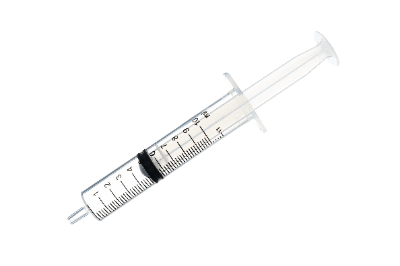What Is a Plastic Syringe?

A plastic syringe is a syringe that is manufactured entirely of plastic .
For disposable syringes that are not all plastic, see Disposable Syringes. A regular syringe has a syringe-like structure in which the gasket on the side of the cylinder (plunger) into which the liquid or gas is pushed is made of rubber.
Plastic syringes, however, are made entirely of plastic, and the rubber material does not leach out, so contamination from the rubber gasket does not occur in the syringe.
Uses of Plastic Syringes
They are mainly used as syringes for measuring specific volumes in medical or scientific experiments where leaching of components from rubber is a concern, or in scientific experiments where rubber can be used under conditions that would alter its properties but plastic can be used.
Plastic syringes have a graduated scale on the outer casing (barrel) to facilitate measuring and transferring the volume of liquid. Plastic syringes are relatively inexpensive and can be disposed of.
Principle of Plastic Syringes
Plastic syringes are designed to be airtight even when only plastic is used. In most cases, the barrel is made of hard polypropylene (PP) and the plunger is made of slightly softer polyethylene (PE), and this combination makes the syringe airtight.
If the gasket is a hard plastic that lacks elasticity, the barrel may be slightly deformed so that it adheres to the gasket to maintain airtightness.
Structure of Plastic Syringe
A plastic syringe is a syringe that consists of an outer tube (barrel), a pump handle (plunger), and a sealing component (gasket) that is attached to the plunger.
How to Choose a Plastic Syringe
1. Material
Make sure the material is suitable for your purpose. Most all-plastic syringes have a polypropylene (PP) barrel and polyethylene (PE) plunger.
2. Maximum Capacity and Scale
Since the size and scale differ according to the maximum volume, selection is made in consideration of the volume and scale increments to be used. While syringes used for medical equipment have a uniform scale for each size, the scale for syringes used for scientific experiments differs depending on the product series.
3. Tip Position (Middle or Side Mouth)
There are two types of plastic syringe tips: those with the outlet in the middle of the syringe tip (middle tip) and those with the outlet on the end (side tip).
Most medium- and small-capacity cylinders have a medium mouth, but most large-capacity cylinders have a side mouth. The advantage of the side mouth is that it is easy to vent even with thick syringes. In the case of medium-volume syringes, there may be products with both medium and horizontal mouths, and in this case, the one that is easier to use in actual operation should be selected.
4. Tip Shape
Since plastic syringes usually do not have a needle or other device attached to the tip, a syringe needle is often used at the tip to reach the liquid surface when the liquid is sucked up. Depending on the situation, a tube may be attached.
Most plastic syringes are luer-slip (luer-tip) or luer-lock syringes. The luer-slip (luer-tip) syringe is designed to hold a needle or other object in place by inserting it straight into the syringe.
The luer-lock type has a stopper that prevents the needle from coming out by rotating and twisting it after inserting it into the tip of the outlet. If there is nothing in particular to attach, a simple luer-slip type is used.
Other Information About Plastic Syringes
Advantages of All-Plastic
The greatest advantage is that since no rubber is used, the risk of rubber-derived contamination is low and the product can be used in solvent conditions that rubber cannot tolerate. The all-plastic design also makes it possible to manufacture the plunger and gasket as a single unit. It also reduces the risk of accidents where the gasket falls off during operation.